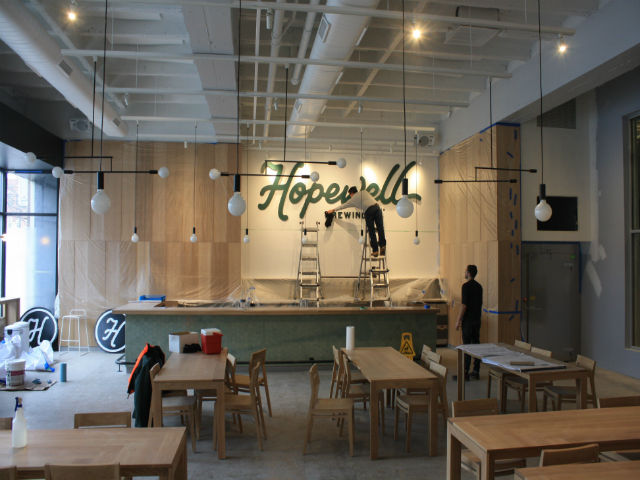Behind The Scenes At Logan Square's New Hopewell Brewing
By Ben Kramer in Food on Jan 21, 2016 5:30PM

Photo provided by Samantha Lee.
Somewhere, at sometime, Stephen Bossu, Samantha Lee, and Jonathan Fritz, three friends who met at the University of Illinois, decided they’d start a brewery. It may have been during a homebrewing session, a cross-country trip where they shared a two man tent between three people, or at Neptune’s Brewery in Livingston, Montana, during said trip. Regardless of when and where the idea came from, Hopewell Brewing (2760 N. Milwaukee Ave.) finally opens for business come the end of January, after six years of planning.
In a city dominated by ales, Hopewell is taking a lager-centric approach. This decision comes from personal preference, admits Head Brewer Stephen Bossu (a former brewer at Brooklyn Brewery), but also because, “There’s less room to hide in a lager,” says Samantha Lee. “If a lager is good, you know it immediately. We like that challenge.”
First Lager, the first beer brewed by the company, and Endgrain Lager are on the core roster. First Lager is described as,” Delightfully crisp, balancing bready malt with pronounced noble hop aroma,”, while Endgrain is said to be maltier and fuller than the former, with a softer hop nose and clear auburn body. The profiles of the brews reflect the attitude of the company: minimal and focused.
Though Fritz, Lee, and Bossu value lagers, that doesn’t mean they’re kicking ales to the curb. Swift IPA, 2437 Red IPA, Farm and Family Saison, are also part of Hopewell’s core, and expect a barleywine to come as well. These beers, while reflecting the company’s minimal and focused approach, also reflect the personalities of the founders. Bossu and Lee lived in Portland for a few years, where they developed a bond with West Coast IPA’s. Swift will be in that vein, with Bossu saying, “I think the flavor characteristic we want to come through most is pine…when pine comes through, it’s that bright, clean hop that you really want to taste and smell.”
The 2437 Red IPA is also a nod to the Pacific Northwest, where Lee fell in love with the style. The ale uses Cascade and Sorachi hops, and the name, for those curious, comes from the number of hours (24) and minutes (37) on a Martian day.

Tanks and brewhouse. Photo provided by Samantha Lee.
Currently, Hopewell runs on a 20-barrel brewhouse system, and houses four fermenting tanks, three 40-barrel fermenters, and one 20-barrel. The reason for the lone 20-barrel? “Well, we wanted to be able to make single batches,” explains Bossu. “We got ten taps upfront. We can have any beers we want on there, so we’ve always wanted to put a single batch in.”
Another benefit with the 20, Lee adds, is, “It allows us to do something funky. Something that we’re trying to test out, get feedback immediately from people.”
The people are as important as the beer to Hopewell, which is why, when designing their taproom, they wanted to have a space that would be open, inviting, and bright. It’s sparse, only containing white walls, oak tables, oak chairs, and the bar, but this arrangement was done to create an open atmosphere, warranting comfort, not congestion, for the drinker.
As they open, the brewery will be draft only, with their beer being available only at the taproom or at certain bars. While they’ll self-distribute (and would like to do so for as long as possible) they won’t necessarily limit themselves to Logan Square because they’d like to share their beer across town. The taproom itself won’t stay open until later than 10 p.m. because, at the moment, they have no plans on being a late night spot. Right now, the focus is serving good beer to the people of Chicago, inviting them to come inside and have a pint or two.